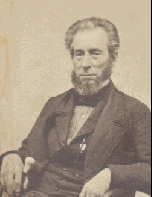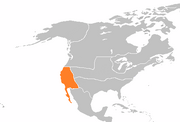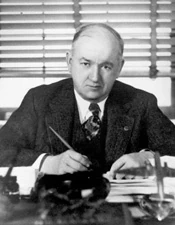| |||||||
| Anthem | "The Golden Nation" | ||||||
| Capital | San Francisco | ||||||
| Largest city | Los Angeles | ||||||
| Other cities | Sacramento, San Jose | ||||||
| Language official |
English | ||||||
| others | Spanish | ||||||
| Demonym | Californian | ||||||
| President | |||||||
| Established | June 14, 1845 | ||||||
| Independence | from Mexico | ||||||
| Currency | Californian Dollar/Confederate Dollar | ||||||
California was an independent nation located on the west coast of North America. Established by immigrants and settlers, it fought for its independence from Mexico in 1845. It would maintain its independence until it was conquered by the United States in World War II.
History[]
Beginnings[]

The founder of Pacifica, William B. Ide
When news reached the settlers of the Mexican War, they decided it was time free themselves and form their own nation. The nation of California was proclaimed, with the capital at Yerba Buena (which was later renamed San Francisco). Mexico relied on the settlers to form their own militias for protection, so the militias outnumbered the Mexican army. Once and the army was defeated and thrown out, news was sent to other cities across the west coast, announcing the independence movement. The other areas soon declared their support for the new republic.
Mexico sent soldiers to deal with rebellion, but the militias united and defended their territory. American and Texan armies campaigned toward and eventually beseiged the capital of Mexico City, forcing Mexico to concede defeat. California won their independence, with William B. Ide was president.
A short year later, gold was discovered, causing a mass immigration to the young nation. Thousands of young men from North America, Europe, and Asia left their homes and traveled to the republic. Many of these immigrants would never return to their old homes, causing Pacfica to become one of the most diverse nations on the continent. These immigrants overwhelmed the nation's infrastructure, which barely existed. Those who failed to find gold were soon employed to build houses, buildings, mines, ranches, harbors, and railroads. In 1854, the first railroad was built, connecting San Francisco to the growing city of Los Angeles to the south.
Establishing its Independence[]
California, however, had enemies. The immigration had disastrous effects on the Native American population, exposing them to new diseases and forcibly removing them from their homes. Hundreds of Indians were slaughtered in massacres, killed by miners and ranchers. In 1856, President Ide refused to run for a third term in office, and was replaced with Peter Burnett. Burnett created the first national army was created, in order to protect new settlers from the Native Americans. The gold rush and mass immigration to California included many from British Canada and Oregon. This vocal minority protested against American attempts of annexation, and both Ide and Burnett did not wish to relinquish their independence to yet another "imperialistic empire". California maintained its independence from America in the 1850s, and allied with Canada.
When the Confederate War of Independence broke out, California remained neutral, although they did send support to the newly formed Confederacy. In 1860, with the Confederates winning victories in the north, and the announcement of Britain's support of the south, Burnett declared war on America and sent his armies to help. Faced with these pressures, American president John C. Fremont requested a ceasefire, and the Confederacy was granted independence. Burnett would visit Confederate president Jefferson Davis in Richmond to congratulate him on his victory, securing the Californian-Confederate alliance.
John McDougall would be elected President in 1864, and continued Burnett's policies. He welcomed Chinese settlers to settle new lands, and was well-connected with miners and ranchers. In his final days in office, he proposed to create a Southern Continental Railroad that would connect Atlantic to Pacific, Confederacy to California, Richmond to San Francisco. The Confederates agreed, and the work on the railroad began. In 1885, another war would break out in North America, and California helped protect the Confederacy, by sending troops to the western states of the Union. The victory of the south and California in the War of 1885 proved to the United States that it couldn't try to dominate its smaller neighbors.
Social Reforms and Industrialization[]

Pacifica after the War of 1885
Following the successful War of 1885, California flourished. New telegraph lines, steamships, and railroads connected the citizens, goods, and ideas of the nation with each other and the Confederacy. Another railroad, completed in 1892, connected San Francisco to the Canadian city of Seattle. Massive waves of Chinese immigration powered the new factories, buildings, and railways of the west. These workers were offered no education or possibility for advancement, lived in terrible working conditions, and paid few wages. The outrage of the treatment of the working class led to the Progressive movement arriving in California and the formation of the Workers Party, the first real opposition to the Bear Flag Party, which had been in charge of the nation since its creation. Founded by Romualdo Pacheco and John Morton Eshleman, the party came to power during the Panic of 1893 that gripped the nation. The Workers Party worked to break up monopolies powerful companies had, improving the working conditions of the lower classes, and work on giving immigrants equal rights. The success the Workers Party had resulted in them taking over as leaders from the Bear Flags, and ensured that Eshleman would be elected president in 1910.
World War I and Aftermath[]
World War I erupted in 1912 between the complex web of alliances around the globe.California went to war against the United States. Its main supply line to the Confederacy was the Southern Transcontinental Railroad, which allowed Pacifica to ship goods, soldiers, and supplies at a quick rate. The entry of Mexico into the war resulted in Mexican troops capturing the railway after a seven-month campaign in 1914, splitting California from the Confederacy. Mexican troops stepped foot in their former territories in 1915, and began pouring into California by the end of the year. American troops, fresh from the surrender of the Confederacy in the east, campaigned in northern California with the aid of Alyeska. Northern California was captured and gave America its coastline.
Mexico would retake the Arizona territory from California, as well as forcing the nation to pay war reparations. The nation's economy plunged as returning veterans found no work, massive hyperinflation gripped the nation, as well as massive debt. New president Emmet D. Boyle inherited a difficult situation and decided to pass the blame; he blamed the California's old enemy, the Native Americans, for losing the war, and attempted to hide the debt through loans and tariffs, Boyle promoted expansion into the sparsley popuated Nevada and Cascade regions, and to develop new infrastructure there. Boyle's plan slowly began to work, and the economy began to revive itself when the Stock Market crashed in 1930 and the world was thrown into the Great Depression, resulted in millions being thrown out of work and millions of dollars lost. Boyle's progress would be set back another decade, which would result in him being kicked out of office and National Socialist James G. Scrugham succeeding him in 1932.
Depression, Dictatorship, and World War II[]

Natsoc dictator James Scrugham
Scrugham founded the Natsoc Party in 1927, following the example from Brazil and Italy, who had already founded parties, and in Italy's case, were in control of the country. Scrugham promised to return prosperity to the country and gain vengeance. Thousands joined his party following the outbreak of the Great Depression and Boyle's inability to handle the crisis, leading to his election in 1932. Scrugham quickly consolidated his power by centralizing the government, outlawing other political parties, taking control of newspapers and other press, and sending those who disagreed with his views to remote camps. Scrugham would remove the little rights the Native Americans had and sent them to labour camps and oppressed the group. Scrugham created building programs that would employ millions in the building of factories, mines, and highways. Others were sent to join the army, which quickly contained thousands more soldiers than the Treaty of Philadelphia permitted. Submarines, planes, tanks, and battleships were constructed as well, though the other powers of the continent turned a blind eye, hoping to appease the nation.
World War II would break out in 1939 between the other Natsoc nations and the London Pact. Confederate President Hugo Black decided it was time to strike to the United States and regain dominance, which it did so by invading the north in 1941. Californian soldiers were sent to take the American seaport of Crescent City, which troops under Earl Warren successful did by the end of summer 1941. The Californians attempted to occupy the remaining western American land, but the entry of Canada and Alyeska in 1942 forced California to go on the defensive. The combined armies of America, Alyeska, and Canada took back Crescent City in 1944, and San Francisco was taken in early 1945. Scrugham was captured and executed by partisan forces.
California would be annexed by the United States and turned into several new states, ending California's century of independence. General Earl Warren became a major force of pacifying the conquered nation, believing that launching a guerrilla war would be "a futile effort with little to gain and lives to lose". Upon San Bernardino's entrance into the Union, Warren became the state's first governor.



